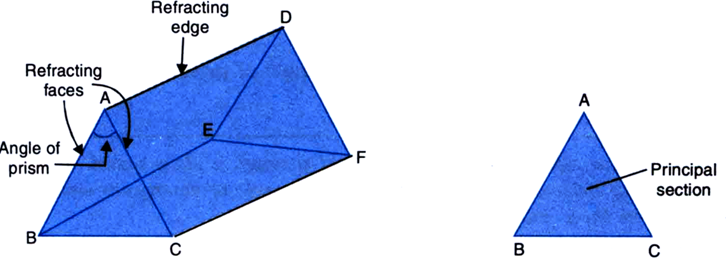
With the help of a diagram of the principal section of a prism, indicate its refractive surfaces, refractive angle, and base.
Answer
499.8k+ views
Hint: Use the concept that a prism is generally made up of two refracting surfaces so the angle between these two refracting surfaces is called a prism angle, moreover when a ray of light passes through the prism it is eventually refracted twice first by the incident refracting surface and then by the second refracting surface, this helps to explain the angle of deviation. The formation of the rainbow can be seen artificially and naturally as well. Use this to approach the problem statement.
Complete step-by-step solution:

From a diagram of the principal section of a prism, the face BCFE opposite to the refracting edge (AD) is called the base of the prism. There are two refractive faces- ACFD and ABED. The angle A at which the two refracting faces are inclined to each other is called the Angle of the prism. A section ABC made by a plane, at the right angle to the refracting edge is called a principal section of the prism. Prism can be made from any material like fluorite, plastic, and glass that is transparent to the wavelength. A dispersive prism can be used to break light rays into spectral colors.
Note:A rainbow can be formed naturally and due to nature as well, in that there are three basic principles involved that is the dispersion of light, reflection, and refraction. In reflection the light waves travel in the same medium and are reflected due to reflecting surfaces, in refraction, the light waves travel from one medium to another medium where the refractive index of the mediums are different. The phenomena of dispersion refer to the principle of separation of the white light into its constituent radiations.
Complete step-by-step solution:

From a diagram of the principal section of a prism, the face BCFE opposite to the refracting edge (AD) is called the base of the prism. There are two refractive faces- ACFD and ABED. The angle A at which the two refracting faces are inclined to each other is called the Angle of the prism. A section ABC made by a plane, at the right angle to the refracting edge is called a principal section of the prism. Prism can be made from any material like fluorite, plastic, and glass that is transparent to the wavelength. A dispersive prism can be used to break light rays into spectral colors.
Note:A rainbow can be formed naturally and due to nature as well, in that there are three basic principles involved that is the dispersion of light, reflection, and refraction. In reflection the light waves travel in the same medium and are reflected due to reflecting surfaces, in refraction, the light waves travel from one medium to another medium where the refractive index of the mediums are different. The phenomena of dispersion refer to the principle of separation of the white light into its constituent radiations.
Recently Updated Pages
Why is there a time difference of about 5 hours between class 10 social science CBSE

In cricket, what is a "pink ball" primarily used for?

In cricket, what is the "new ball" phase?

In cricket, what is a "death over"?

What is the "Powerplay" in T20 cricket?

In cricket, what is a "super over"?

Trending doubts
What are the major means of transport Explain each class 12 social science CBSE

Which are the Top 10 Largest Countries of the World?

Draw a labelled sketch of the human eye class 12 physics CBSE

How much time does it take to bleed after eating p class 12 biology CBSE

Explain sex determination in humans with line diag class 12 biology CBSE

Explain sex determination in humans with the help of class 12 biology CBSE




